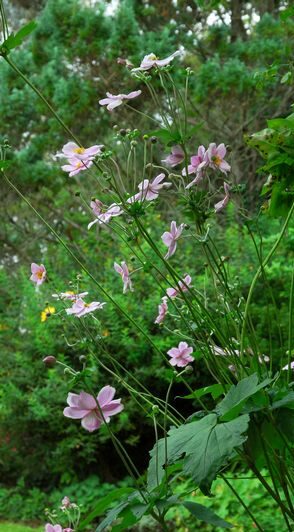
Rather discreet during the spring, the anemones of Japan show their best days from the end of the summer until the first frosts, stretching their long stalks covered with flowers towards the heavens. Robust, these herbaceous plants are then without complex among the most beautiful perennials of summer and autumn.
3 tips for successful Japanese anemones
“The ground at their feet must remain cool in summer. Regularly renewed mulch helps maintain this freshness.
Install the Japanese anemone in partial shade. This is the exposure that suits him best.
Take its suckering stems to multiply it easily and give some.”
Description
The Japanese anemone forms in a few years beautiful clumps of 1 m to 1 m 60 high and about fifty centimeters wide.
The slender, grey-green stems, covered with small hairs, are robust and stand up straight.
The deciduous foliage, rough and dark green, is composed of toothed leaflets.
The flowers, single or double depending on the variety, bloom in a cup at the top of long branched stems. Their green heart, surrounded by a crown of golden stamens, is original.
The pearly-white petals of the Japanese anemone honorine Jobert , pinkish on the underside and of great finesse, play with the light of the sun to offer games of transparency. Flowering extends from mid-August until the first frosts, the plant carrying throughout the fall an alternation of open flowers and elegant buds ready to bloom.
Which soil for the Japanese anemone?
The Japanese anemone appreciates rich soils, remaining cool in summer. Clay soils are acceptable provided they are well drained in winter. The plant also tolerates slightly calcareous soils but it prefers more neutral or acid-prone soils.

Where to plant Japanese anemone?
In light shade or non-burning sun. Too much sun damages the foliage and quickly scorches the flowers. In semi-shaded conditions, if the soil remains cool, the Japanese anemone can even be invasive.
When and how to plant Japanese anemone?
In areas with mild winters, planting can be done already in the fall. Elsewhere, early spring is preferable. Count 4 plants per m² . Lighten clay soils by mixing a good compost or leaf mix. Let the root ball soak for about ten minutes before planting and install it, letting it protrude slightly from ground level to improve drainage. Finish with a mulch or shredded mulch to limit watering. After the first year, watering is no longer necessary.
What maintenance?
Regularly renew the mulch at the base and water regularly in dry weather. The soil should not dry out.
In regions with a harsh climate, protect young plants of the Japanese anemone , as winter approaches, under a carpet of dead leaves. Elsewhere and later, the gesture is useless, the plant being hardy down to -15/-20°C.
Adding fertilizer is unnecessary. It favors the production of foliage to the detriment of flowers. A contribution of compost, each year at the beginning of spring, is on the other hand beneficial to lighten the ground and improve its structure.
When and how to prune Japanese anemone?
Wait until late fall to clean up the clump. Then cut back all the stems to ground level.

How to propagate Japanese Anemone?
The Japanese Anemone spreads naturally by emitting underground rhizomes.
It is also sometimes necessary to limit the extension of the tuft if it becomes troublesome.
You can also take advantage of this ease of spreading to take in the fall or at the end of winter, from the periphery of the stump, pieces of suckering roots, comprising one or more buds.
Replanted elsewhere in the garden, they will resume and give rise to new plants .
What to combine Japanese Anemone with?
For a nice effect, plant the Japanese anemone in groups of 4 to 5 plants. This ranunculaceae then brings volume to the massifs and can be used as well in an isolated way, at the edge of the lawn or driveway for example.
It goes naturally very well with other summer or autumn flowering perennials: acanthus, Jupiter’s helmets, foxgloves, daylilies, loosestrife, asters, sedum spectabile, autumn daisies, late geraniums , or fall-flowering grasses.
Do not hesitate to regularly pick its flowers or its elegant buds to compose pretty bouquets.
Japanese Anemones
The term Japanese anemones actually includes 3 varieties: Anemone hupehensis (from China), all hybrid anemones (Anemone x hybrida) and Anemone tomentosa . They all have in common that they take quite a long time to establish, but they are generous in the following years. Created in the 19th century (1858), Honorine Jobert , a hybrid anemone with white flowers, is one of the most classic varieties.
Japanese anemone Königin Charlotte
Robust and vigorous, nearly one meter tall, the “Königin Charlotte” variety, with pale pink flowers with a green heart and very dark green leaves, is one of the most beautiful and well-known there is.
